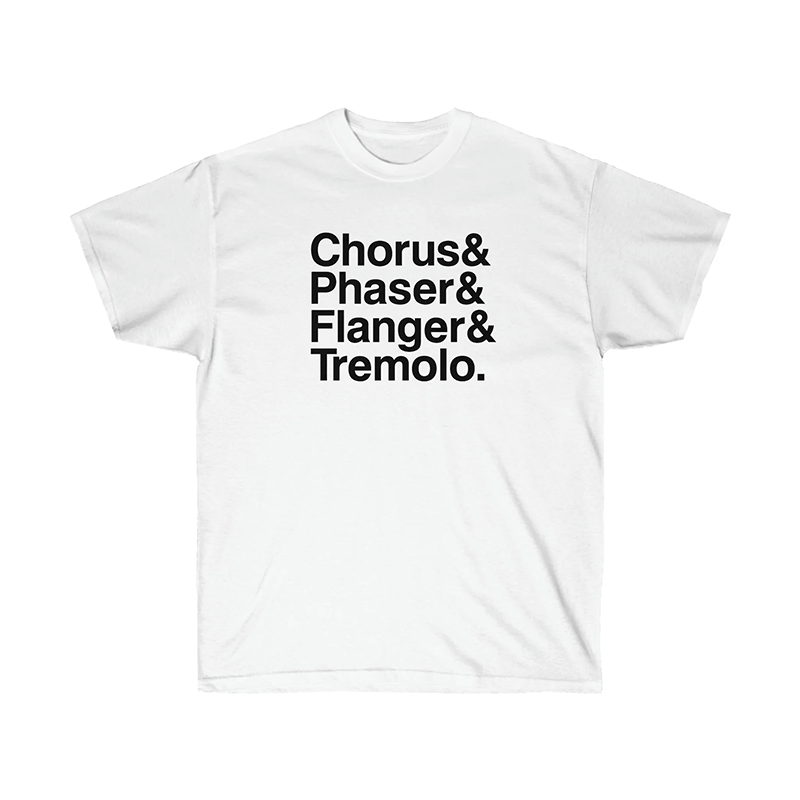John Snyder
Electronic Audio Experiments
Boston, MA
http://www.electronicaudioexperiments.com
How long have you been a musician? How did you get into it in the first place?
 My first instrument was actually the violin, which I began playing at age six. I took private lessons for about twelve years, firmly establishing classical music as a big part of my musical DNA. I listened to all types of music growing up, but I only started playing the guitar when I was a teenager because I wanted to start a pop-punk band with my friends. That didn’t last long, of course. I played in a number of heavier bands throughout high school and college and now I perform solo ambient/drone music and play guitar in a screamo band.
My first instrument was actually the violin, which I began playing at age six. I took private lessons for about twelve years, firmly establishing classical music as a big part of my musical DNA. I listened to all types of music growing up, but I only started playing the guitar when I was a teenager because I wanted to start a pop-punk band with my friends. That didn’t last long, of course. I played in a number of heavier bands throughout high school and college and now I perform solo ambient/drone music and play guitar in a screamo band.
Who have been some of your major musical influences, past or present?
My parents did a great job of exposing me to all kinds of music, but when I was young I gravitated towards classical, baroque, and romantic music. As a teenager I listened to a lot of pop-punk and post-hardcore and still enjoy a lot of that. A big turning point for me was when I first listened to Radiohead. Kid A served as my gateway drug into weirder music. I got into post-rock after discovering Sigur Ros, Godspeed, and Braveyoung, which in turn drew me into modern classical music and ambient music. Somewhere along the way began listening to drone/doom/stoner metal and variants thereof. Nowadays I listen to some mix of all of the above and my preferred records change all the time. I think the basic requirements for me are awareness (explicit or implicit) of interesting music theory, talented yet tasteful musicianship, good production, and originality.
What led to the start of Electronic Audio Experiments? How long have you been in business?
 EAE started on a whim, to be honest! For the first several months I used it as the brand name for DIY builds that I would sell at cost to friends. Like many guitarists I went through an absurd buying/selling/trading phase and offered rig advice to others, but once I become more confident in my electronics skills I started to build things rather than buy them. Recommending gear to others eventually became “hey let me whip this thing up for you,” so EAE was sort of a natural extension of what I was already doing.
EAE started on a whim, to be honest! For the first several months I used it as the brand name for DIY builds that I would sell at cost to friends. Like many guitarists I went through an absurd buying/selling/trading phase and offered rig advice to others, but once I become more confident in my electronics skills I started to build things rather than buy them. Recommending gear to others eventually became “hey let me whip this thing up for you,” so EAE was sort of a natural extension of what I was already doing.
I think it became a “real” pedal company with the launch of the Longsword V1 last spring. It was my first original design that I had taken from concept to reality. Things have greatly improved since then. It’s been just me this whole time but I will probably have a contracted builder or two by the end of 2016, allowing me more time to focus on R&D and custom projects… or, you know, have a life. I have no plans to take this full time.
Did you have formal schooling, or are you self-taught? Take us through that story:
When I was in high school I interned at a small electronics company in Connecticut where I learned about assembly, good wiring practices, and some electrical design. I also learned the ins and outs of quality manufacturing (e.g. ISO). Even though I operate out of a small workshop in my home, those concepts are useful today.
During undergrad I studied physics, which included coursework on the broader, conceptual aspects of electromagnetics. I learned how transistors worked at the quantum level but didn’t actually make anything with them. So I supplemented that coursework with some electronics classes and got hooked.
Once I picked up the basics I began studying audio circuits in earnest. Most classic guitar pedals can be analyzed after one or two semesters of basic electronics – it’s all about transistors, op amps, and filters. A big part of putting it all together was talking to other builders, lurking on forums, and reading articles by RG Keen, Jack Orman, Beavis Audio, and others. I’m still not an expert by any means but I take a lot of joy in constantly learning and improving.
I am currently in an electrical engineering graduate program, but I research quantum optics and do essentially zero actual electronics work in my lab. All of the EE stuff comes into play when I’m working as a TA. Teaching is a great way to stay fresh on the basics and is incredibly fun.
What drives you as far as new pedal creation is concerned? How long does it typically take for an idea to come full circle and become a demo pedal? What’s the process behind new gear, and the eventual release of it to the public?
 New pedal designs are driven in a few ways. Often my inspiration comes from what I perceive to be gaps in my own rig, first and foremost. By extension that often translates to a gap in the market, though not always—convergent evolution is everywhere in the pedal world. Sometimes I’ll see a cool design choice in a circuit that isn’t a pedal. Lately I have been looking at schematics for early microphone preamps, radio amplifiers, or instrumentation amplifiers to find unique gain stages. Or I’ll check old textbooks for circuit building blocks that aren’t commonly used today.
New pedal designs are driven in a few ways. Often my inspiration comes from what I perceive to be gaps in my own rig, first and foremost. By extension that often translates to a gap in the market, though not always—convergent evolution is everywhere in the pedal world. Sometimes I’ll see a cool design choice in a circuit that isn’t a pedal. Lately I have been looking at schematics for early microphone preamps, radio amplifiers, or instrumentation amplifiers to find unique gain stages. Or I’ll check old textbooks for circuit building blocks that aren’t commonly used today.
Regardless of their origin, new ideas end up in LTSpice before I do anything else. Simulation tells me if a design is actually going to pass a signal, have gain, have a useful frequency response, and more. It’s amazing for setting up tone stacks and biasing gain stages, for example. From there I either go to the breadboard or just draw up a PCB and send it out for fabrication. Then prototyping begins. The whole process can take anywhere from an afternoon (the mu blaster) to six months (the Model feT) depending on the complexity of the design and how much of a perfectionist I’m being. Development hell is real, but the results are worth it.
Artwork, marketing, release methods, and all that stuff tend to happen haphazardly for me. It’s not that I don’t care about those things, but they’re not high priority either. I try to let the pedals speak for themselves. Usually a good sound clip is all I need, and from there I can take orders.
What are some of the biggest concerns facing your profession today?
I think the pedal industry has an originality problem. Oversaturation and plagiarism go hand-in-hand. So many pedals are a copy of a copy of a copy. In the grand scheme of things, it’s not hard to make a pedal that is actually new. It can be as simple as taking two existing building blocks and putting them together in a new way. We don’t really need more clones of the Tubescreamer or Rat or Big Muff. We don’t need more pedals that are someone else’s design with a bunch of extra toggles and knobs that don’t do anything. But that’s just my personal feeling on the matter. Builders would not be doing tweaked copies of things if there were no market for it.
Where do you see pedal building going in the future?
 There’s a big wave of formerly “boutique” companies developing huge manufacturing operations. They’re going to become the next Boss/Digitech/Ibanez and a new wave of boutique builders will do their thing. I don’t see a whole lot changing there. I feel like there might be more small companies than there once was, but I might just be more aware than I once was. The barriers to entry are lower than ever. I can design a PCB in Eagle and send it out to fabrication at OSH Park while drinking a beer on my couch!
There’s a big wave of formerly “boutique” companies developing huge manufacturing operations. They’re going to become the next Boss/Digitech/Ibanez and a new wave of boutique builders will do their thing. I don’t see a whole lot changing there. I feel like there might be more small companies than there once was, but I might just be more aware than I once was. The barriers to entry are lower than ever. I can design a PCB in Eagle and send it out to fabrication at OSH Park while drinking a beer on my couch!
I think DSP will continue to get more accessible as well. The best modelers are already so close to real amps and they will continue to get better. But I think all instruments are ultimately rooted in the technology of the era when they were invented. I think about violins and other bowed instruments. Obviously better materials than wood are out there, but a plastic or acrylic violin just isn’t the same.
Who are some of your favorite builders in the industry right now?
Nicholas Williams at Dunwich Amps is an inspiring builder, helpful electronics guru and a good friend. His wiring is some of the cleanest in the game. Lately we’ve been enabling each other’s weird ideas and it’s great.
Scot Debockler at S&K Pedals is another good friend and partner in crime. His operation is every bit as small as mine, but the VHD (Ampeg VH140c in pedal form) and Grey Ghost distortion are incredible pedals.
Brad Macomber at Nerd Knuckle Effects was kind enough to lend me a spot on his workbench when I had to get work done in the middle of moving to a new apartment, and we’ve been friends ever since. He’s a fellow Boston builder with some killer drive pedal designs. My current favorite of his is the Martyr Box, a really thick and textured boost/OD/fuzz made from old Russian transistors.
Philippe Herndon at Caroline Guitar Co – always making pedals that are accessible, versatile, and original. Also known to occasionally write an amazing opinion piece that ends up in some guitar magazine. The Wave Cannon V1 is one of my all-time favorite drives and I’ve owned two Kilobytes.
Brian Hamilton at Smallsound/Bigsound – I bought a Mini during the 2014 Black Friday sale and ended up meeting Brian at a Cymbals Eat Guitars show in Boston. He’s a super cool guy and has let me pick his brain on occasion.
Name the last 5 records you listened to:
1. Here Come the Warm Jets by Brian Eno
2. Endless Light by O’Brother
3. Carrie and Lowell by Sufjan Stevens
4. Cardinal by Pinegrove
5. Pink by Boris
Klon hype: Love it or Hate it?
The Klon is a great circuit assuming you already have a good guitar and amp. I don’t buy into the magic diode hype or anything (the D9E is simply a germanium diode with a slightly higher forward voltage than a 1n34a – I dig them in the Longsword V2!) but I think the design is well thought-out. I’d never buy an original because the cost is absurd, but the KTR is rad. I’ve also thought about cloning one for myself just to have on hand. That being said I’ve always had respect for Bill Finnegan. He’s a perfectionist who loves his craft. I know he lives somewhere near Boston, but he’s a private guy and we’ve never crossed paths.
Any last comments, or anything you’d like to talk about?
 First, if you want to hear what drives my tonal interests you can check out my musical projects Ember Wreath (ambient/drone) and Tiny Fractures (emo/screamo). Lots of EAE gear can be found on those recordings.
First, if you want to hear what drives my tonal interests you can check out my musical projects Ember Wreath (ambient/drone) and Tiny Fractures (emo/screamo). Lots of EAE gear can be found on those recordings.
Second, my next big goal after production settles down is to produce some educational content and open-source designs. I owe a lot to the DIY community and I think it’s time to give back, at least in some small way.
Finally, thanks to everyone who has supported what I do!
Thanks so much to John for taking the time to answer some questions!
Make sure to go check out www.electronicaudioexperiments.com, cheers!
GET EXCLUSIVE UPDATES, CONTEST INFO, SEE OUR LATEST DEMO VIDEOS AND MORE:

















Trackbacks/Pingbacks